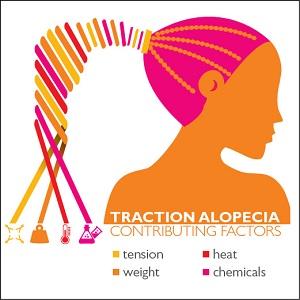[dropcap style=”font-size:100px; color:#992211;”]H[/dropcap]igh traction hairstyles have (and perhaps this is a little obvious, no?) a long-term effect on the wearer, leading in some cases to irreplaceable hair loss.
Schadenfreude for sufferers of other people’s man-buns worldwide.
(N.B. For our transatlantic readers, a man-bun is a (stupid) hairstyle, not a reference to boybuttocks.)
In a review of 19 studies, researchers at Johns Hopkins say they can confirm a “strong association” between certain scalp-pulling hairstyles — many common among African-Americans — and the development of traction alopecia, gradual hair loss caused by damage to the hair follicle from prolonged or repeated tension on the hair root. An estimated one-third of African-American women suffer from traction alopecia, making it the most common form of hair loss among that group.
In a report on their analysis, published ahead of print in the Journal of the American Academy of Dermatology, the investigators urge dermatologists to better educate themselves about the damaging hairstyles — which include tight ponytails, braids, knots and buns — and advise patients of risks and alternatives.
“Hair is a cornerstone of self-esteem and identity for many people,” says Crystal Aguh, M.D., assistant professor of dermatology at the Johns Hopkins University School of Medicine, “but ironically, some hairstyles meant to improve our self-confidence actually lead to hair and scalp damage.” Traction alopecia, she adds, is entirely preventable, and early intervention can stop or reverse it. “We have to do better as care providers to offer our patients proper guidance to keep them healthy from head to toe,” she says.
In their research review, Aguh and her colleagues categorize hair practices into low-, moderate- and high-risk styles based on the degree to which follicles are exposed to tension, weight, heat and hair-altering chemicals, such as straighteners.
Moderate-risk styles, the authors say, include some of the same styles noted to be high risk, but because they are performed on natural, unprocessed hair, they are less likely to result in hair loss. Low-risk styles generally included low-tension styles, such as loose buns, and loose-hanging styles, such as wearing the hair down, as well as practices that decrease the amount of friction on the hair and scalp and avoid chemical relaxers. Aguh and her colleagues say the highest-risk styles include braids, dreadlocks, weaves and extensions, especially when applied to chemically straightened hair. These styles are popular among African-Americans, she says, because they are low maintenance and chemical-free, but the constant pulling of the hair in one direction, the tight-locking patterns and added weight can result in significant breakage and eventually traction alopecia.
Damage can also be done if extensions are affixed with adhesive glue put directly on the scalp, especially when the glued-on hair is removed. Chemical straightening weakens the hair shaft, causing breakage.
In the more moderate risk category are thermal straightening, permanent waving and use of wigs. Temporary thermal or heat-related straightening of the hair, such as the use of flat irons and blow drying the hair — while not by itself significantly associated with traction alopecia — can weaken shafts, leading to “significant” hair loss when traction is applied, the researchers conclude. Permanent waves made with ammonium thioglycolate to create or alter curl pattern, together with added tension from chemical treatment, do the same. And wigs attached with clips and adhesives to keep them in place can cause significant breakage.
Aguh also noted that cotton and nylon wig caps that rub the hairline may also weaken hair shafts, while satin ones are less likely to do so. Observations among clinic patients reported in the reviewed studies, Aguh says, found that loose, low-hanging styles or even updos are low risk for traction alopecia. So are natural styles that avoid chemicals and the use of frequent moisturization with conditioning agents.
Untreated and unprocessed hair, she says, can withstand greater traction, pulling and brushing, and overall decreases the risk of traction alopecia, regardless of styling.
In their review, the investigators also offered guidelines for dermatologists and other care providers to prevent and manage hair loss from traction alopecia. The first line of therapy, they say, is to loosen braids and other high-tension styles, as well as weight on the follicle permanently or periodically. Braided hairstyles should be in place no longer than two to three months, they say, and weaves and extensions should also be removed for a period of time after six to eight weeks.
The investigators also recommend people alternate styles, mainly reducing or avoiding updos, to allow follicles to recover from stress.
“Dermatologists need to be conscious of the fact that many high- and moderate-risk hairstyles greatly improve hair manageability, and simply telling patients to abandon them won’t work for everyone,” says Aguh. “Instead, physicians can educate themselves to speak with patients about making the best hairstyling choices to minimize preventable hair loss.”
Source: Eurekalert/Johns Hopkins Medicine

Some of the news that we find inspiring, diverting, wrong or so very right.




















